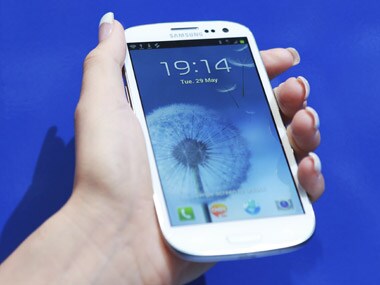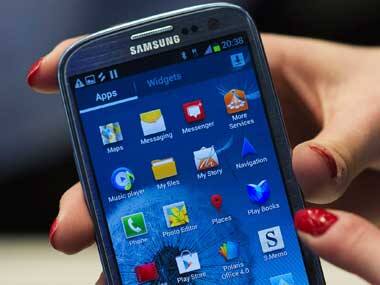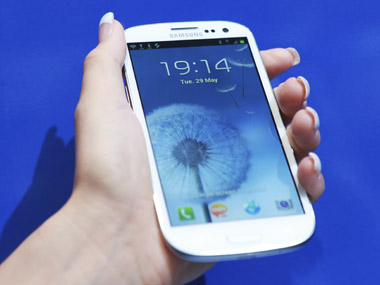By
Roydon Cerejo , Karan Shah
Samsung’s Galaxy S III has finally hit Indian shores and loyal Sammy fans can’t wait to get their grubby mitts on one. Should you ditch your S II to buy the new phone? Well here’s the verdict on the phone’s design and interface. Design and Build quality This is a very touchy subject with many tech enthusiasts, as the initial impressions of the S III left a rather bad taste in everyone’s mouth. The S III isn’t much of a looker and when you compare it to its predecessor, it pales in comparison, or does it? Honestly we didn’t know what to expect, but after actually holding it in our hands, it did’nt seem so bad, at least from up-front. The HyperGlaze coating on the body gives it a nice finish that does prevent light scratches and fingerprints. Of course the white model could also cover that up to quite an extent. The blue version of the phone will be launching later in the month. Samsung has stated time and again that the phone was heavily inspired by nature and yes, the S III does looks like an oversized pebble. We bet if you threw it just right, it would make three nice little bounces on the water (don’t do that though!). iFixit reports that the Corning Gorilla Glass is actually fused to the display and while this does a good job in shrinking the width of the S III, cracking the glass of the phone could also mean cracking the display, itself so replacing it would be an expensive affair. [caption id=“attachment_337105” align=“alignleft” width=“380” caption=“The one thing that you definitely can’t get away from is the plastic feel of the phone. Reuters”]
 [/caption] The one thing that you definitely can’t get away from is the plastic feel of the phone. At 8.6mm in depth and a weight of 133 grams, it’s incredibly slim and light. Samsung has managed to shave off as much of bezel as possible, so all you’re really left with is this gigantic screen, and we love it! The battery is removable, unlike the HTC One X, but the rear cover itself is dangerously flimsy. Apparently, the rear cover is made from polycarbonate and not plastic, so it should be more durable than it appears to be.The phone accepts a microSIM only, so make sure you have one before buying it. The S III clearly pales in comparison to the design and aesthetics of the One X, which has a much more premium finish to it. Being a flagship device, we did expect a lot more from Samsung in this department. It looks good from the front, but we really wished they would have done a better job with the back panel and the overalls. We’re not saying go overboard, but give us something that looks like it’s going to last. If it’s a flagship, doesn’t it need to feel like one as well, Samsung? Interface The Samsung Galaxy S III comes with Android 4.0.4 (or Ice-Cream Sandwich) out of the box, however, we have to deal with TouchWiz again, this time inspired by nature! They call it — TouchWiz Nature UX, but we failed to see any connection with the skin and nature excpet for the water disturbed screen effects that are also available in any other Android device with Live wallpapers. Moving on, Samsung has tweaked and changed a few things to give it a fresh look. The lock screen is no longer a glass, but has water effects instead. Touching it creates ripples on the screen and you simply swipe anywhere in order to unlock it. You can also add and slide over shortcut icons to open that app directly. They’ve also added a slide up notification bar from the bottom that updates you on missed calls, unread messages, etc. Upto 7 home screens are allowed. The notification bar plays host to plenty of toggle switches and this time, Samsung has made it scrollable to accommodate more of them. Samsung has stuck to their three button layout, which we are thankful for. The ‘Options’ and ‘Back’ button are where they should be, while the center physical buttons take you home on single click, lets you switch launchers on double click and brings up the running apps on long press. It’s simple and works like a charm. The app menu is similar to stock Ice-Cream Sandwich (ICS), except for the theme and Samsung’s icons. One thing we wished Samsung kept from stock ICS was automatic folder creation. It’s just more simple to drag an icon over the other and create a folder rather than creating one separately and then add apps in it. Plus, ICS folders are way cooler than anyone else’s. The Galaxy S III is powered by a 1.4GHz Exynos 4212 quad-core processor with 1GB of RAM and 16 gigs of onboard storage. It’s blazing quick in every single aspect and manoeuvring through the various menus, home screens as well as multitasking is an absolute breeze. While performance is top notch, we did have an occasional hiccup as the phone would catch its breath, before resuming normal dazzling speeds. Samsung’s TouchWiz UX may be superquick and all of that, but it doesn’t really look all that fancy. Beneath the glossiness that they’ve given it, lies a stark and glum feel that could definitely do with better colour schemes. [caption id=“attachment_337106” align=“alignright” width=“380” caption=“S III is excellent when it comes to media playback and benchmarks, not forgetting battery life as well. Reuters”]
[/caption] The one thing that you definitely can’t get away from is the plastic feel of the phone. At 8.6mm in depth and a weight of 133 grams, it’s incredibly slim and light. Samsung has managed to shave off as much of bezel as possible, so all you’re really left with is this gigantic screen, and we love it! The battery is removable, unlike the HTC One X, but the rear cover itself is dangerously flimsy. Apparently, the rear cover is made from polycarbonate and not plastic, so it should be more durable than it appears to be.The phone accepts a microSIM only, so make sure you have one before buying it. The S III clearly pales in comparison to the design and aesthetics of the One X, which has a much more premium finish to it. Being a flagship device, we did expect a lot more from Samsung in this department. It looks good from the front, but we really wished they would have done a better job with the back panel and the overalls. We’re not saying go overboard, but give us something that looks like it’s going to last. If it’s a flagship, doesn’t it need to feel like one as well, Samsung? Interface The Samsung Galaxy S III comes with Android 4.0.4 (or Ice-Cream Sandwich) out of the box, however, we have to deal with TouchWiz again, this time inspired by nature! They call it — TouchWiz Nature UX, but we failed to see any connection with the skin and nature excpet for the water disturbed screen effects that are also available in any other Android device with Live wallpapers. Moving on, Samsung has tweaked and changed a few things to give it a fresh look. The lock screen is no longer a glass, but has water effects instead. Touching it creates ripples on the screen and you simply swipe anywhere in order to unlock it. You can also add and slide over shortcut icons to open that app directly. They’ve also added a slide up notification bar from the bottom that updates you on missed calls, unread messages, etc. Upto 7 home screens are allowed. The notification bar plays host to plenty of toggle switches and this time, Samsung has made it scrollable to accommodate more of them. Samsung has stuck to their three button layout, which we are thankful for. The ‘Options’ and ‘Back’ button are where they should be, while the center physical buttons take you home on single click, lets you switch launchers on double click and brings up the running apps on long press. It’s simple and works like a charm. The app menu is similar to stock Ice-Cream Sandwich (ICS), except for the theme and Samsung’s icons. One thing we wished Samsung kept from stock ICS was automatic folder creation. It’s just more simple to drag an icon over the other and create a folder rather than creating one separately and then add apps in it. Plus, ICS folders are way cooler than anyone else’s. The Galaxy S III is powered by a 1.4GHz Exynos 4212 quad-core processor with 1GB of RAM and 16 gigs of onboard storage. It’s blazing quick in every single aspect and manoeuvring through the various menus, home screens as well as multitasking is an absolute breeze. While performance is top notch, we did have an occasional hiccup as the phone would catch its breath, before resuming normal dazzling speeds. Samsung’s TouchWiz UX may be superquick and all of that, but it doesn’t really look all that fancy. Beneath the glossiness that they’ve given it, lies a stark and glum feel that could definitely do with better colour schemes. [caption id=“attachment_337106” align=“alignright” width=“380” caption=“S III is excellent when it comes to media playback and benchmarks, not forgetting battery life as well. Reuters”]
 [/caption] The main section where the Galaxy S III blows the competition out of the water is the synthetic benchmarks. Quadrant, which is a CPU, I/O and 3D graphics benchmark, gave the S III a mammoth score of 5419, close to 750 points ahead of the One X. NenaMark 2, an OpenGL benchmark gave the S III a score of 58.8 fps, beating the One X’s 47.2 fps. The Lava Xolo X900 that we reviewed earlier came in at a close third position. The advantage of using the Exynos chipset is a clear advantage for the S III over its rivals, as they slowly chug along at the back, while it blazes off ahead. The complete list of benchmarks can be viewed below. Verdict Samsung has priced their flagship offering at 43,180, however actual retail pricing is closer to 38,900. This is still a little bit more expensive compared to the HTC One X, although the latter has been in the market for a while longer. Once things normalise, it should be on par. Now for the million dollar question, which one do you buy? While this is best left up to a grudge match, we’d have to put our money on the HTC One X and here’s why. The S III is excellent when it comes to media playback and benchmarks, not forgetting battery life as well. These are some of the areas where it leaves the competition behind. In the real world, Tegra 3 is every bit as good as Exynos 4 Quad, as far as app access and overal functionality go. We really doubt you’ll able to tell any difference unless you look real close. The rest of the features and performance, while high on the scale aren’t impressive enough to deviate our choice from the One X over the S III. It doesn’t really have anything that would make us run out to a store and buy it. The Nokia PureView has the 41MP camera, the One X has an amazing burst mode, the Xperia S, once again is brilliant at macro shots and here we have the Galaxy S III whose highlight is a bunch of random gesture and voice-based programs and the fact that it’s designed for humans. You see our point? There’s no singular feature that’s captivating enough for us to wholeheartedly recommend this phone. We feel Samsung have bitten off a bit more than they they can chew, which could be the undoing for the Galaxy S III. Editor’s note: This review was published at Tech2.in. For the full version you can click
here
.
[/caption] The main section where the Galaxy S III blows the competition out of the water is the synthetic benchmarks. Quadrant, which is a CPU, I/O and 3D graphics benchmark, gave the S III a mammoth score of 5419, close to 750 points ahead of the One X. NenaMark 2, an OpenGL benchmark gave the S III a score of 58.8 fps, beating the One X’s 47.2 fps. The Lava Xolo X900 that we reviewed earlier came in at a close third position. The advantage of using the Exynos chipset is a clear advantage for the S III over its rivals, as they slowly chug along at the back, while it blazes off ahead. The complete list of benchmarks can be viewed below. Verdict Samsung has priced their flagship offering at 43,180, however actual retail pricing is closer to 38,900. This is still a little bit more expensive compared to the HTC One X, although the latter has been in the market for a while longer. Once things normalise, it should be on par. Now for the million dollar question, which one do you buy? While this is best left up to a grudge match, we’d have to put our money on the HTC One X and here’s why. The S III is excellent when it comes to media playback and benchmarks, not forgetting battery life as well. These are some of the areas where it leaves the competition behind. In the real world, Tegra 3 is every bit as good as Exynos 4 Quad, as far as app access and overal functionality go. We really doubt you’ll able to tell any difference unless you look real close. The rest of the features and performance, while high on the scale aren’t impressive enough to deviate our choice from the One X over the S III. It doesn’t really have anything that would make us run out to a store and buy it. The Nokia PureView has the 41MP camera, the One X has an amazing burst mode, the Xperia S, once again is brilliant at macro shots and here we have the Galaxy S III whose highlight is a bunch of random gesture and voice-based programs and the fact that it’s designed for humans. You see our point? There’s no singular feature that’s captivating enough for us to wholeheartedly recommend this phone. We feel Samsung have bitten off a bit more than they they can chew, which could be the undoing for the Galaxy S III. Editor’s note: This review was published at Tech2.in. For the full version you can click
here
.
Samsung Galaxy S III review: Oversized pebble or Android king?
FP Archives
• June 8, 2012, 16:56:20 IST
Samsung’s Galaxy S III has finally hit Indian shores. So is the phone better than HTC One X, the iPhone 4S or just an oversized pebble? Here’s our review of the smartphone.
Advertisement
)